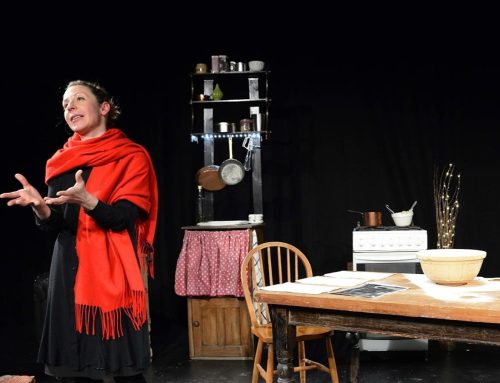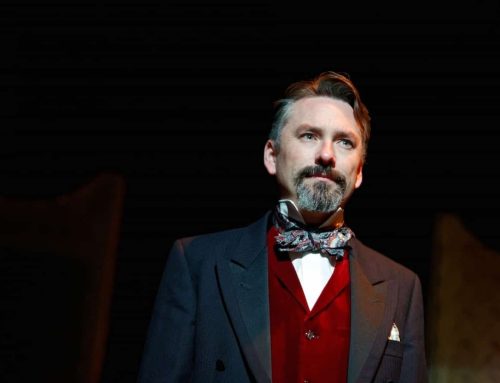Bracknell based touring company Blackeyed Theatre has had something of a success in recent years with well-produced, reassuring, and true-to-the-book adaptations of popular classics from British literature, including this year’s Frankenstein and Jekyll & Hyde. Adapter / Director Nick Lane’s 2018 excursion into the world of Sherlock Holmes, The Sign of Four, toured widely and was generally well received. This year’s follow-up, The Valley of Fear, based on the last of Conan Doyle’s four full length Sherlock Holmes novels, does not exactly set the stage alight with the novelty of its approach. But it is fair to say if you like your Holmes traditional, and your Watson reassuringly sleepy, and put-upon, you will find much to enjoy in this competent (if a tad slow-moving) production.
Holmes (Luke Barton who enjoys a remarkable similarity to TV actor Matt Smith) and Watson (Joseph Derrington) are relishing a quiet day at 221B Baker Street when an encoded note arrives from an informant. The missive warns of imminent danger to John Douglas, squire of the mysterious Birlstone House in Kent. Just as the revered detective is mulling over the note’s possible significance, Scotland Yard Inspector MacDonald arrives bearing news of the unfortunate country gentleman’s violent demise. He seeks the urgent assistance of Holmes and Watsons with the case. The game’s afoot.
Hastening to Kent in search of answers, the duo, soon joined by plodding local police detective Mason (Blake Kubena), encounter a satisfyingly mysterious set of incidents to resolve. Just why is Ivy (Alice Osmanski), the supposedly loving wife of the late Douglas, so apparently unfazed by his murder? And why is family friend Cecil Barker (Gavin Molloy), who discovered the mutilated body, providing a version of events that simply does not add up?
The Valley of Fear is a tricky novel to adopt for the stage because it comprises two separate shorter story sequences. The first relates to events in Kent and the second to Douglas’ adventurous life decades earlier, in Pennsylvania’s crime ridden Vermissa Valley. The novel presents each narrative sequentially, but Lane has chosen to present them simultaneously, with scenes constantly switching between locations and decades. It is an elegant enough concept, but the execution relies on an awful lot of pace-braking exposition from Watson as narrator in both timelines. The Kent scenes generally work, zipping along with the comfortable momentum of a sleepy 1890s steam train. But the those set in America often drag, particularly in the prolonged second half. It feels as if Lane is reluctant to give up on some of the minutiae of the American backstory for fear of doing an injustice to the Conan Doyle original. Some judicial editing might make these scenes a bit peppier in what occasionally feels likes an over-long show.
Sherlock’s dastardly antagonist Professor Moriarty makes an unexpected appearance in flashback form mid-way, which is an invention that may annoy Sherlockian purists. Lane’s intent here seems to be to introduce some welcome conflict between the detective and his sidekick. The play is certainly at its freshest and sparkiest in the sporadically uncomfortable moments of emotional tension between the two. Dr Watson is never entirely sure that Holmes is a man to be trusted and we can see why.
The ensemble actors are tasked with carrying off no less than 20 roles. The multitasking, in the main, works, even if the American accents haphazardly drift back into home counties English from time to time. Barton’s Holmes feels too young, even jejune, to be wholly convincing as the famous detective. But he certainly gets the obsessive self-reverence of Conan Doyle’s creation spot on. Derrington’s Dr Watson brings much needed light and shade to a lorry-load of narrative exposition throughout and makes the most of the show’s few comic exchanges. Kubena adds taciturn, mid-western charm to his turn as the sly but virtuous Pinkerton detective, Birdy Edwards.
Victoria Spearing’s pleasingly snug single set, William Morris style embroidered hangings set against a sparse wooden framework, manages to convince as both rural Pennsylvania and an Elizabethan country pile. The design motifs, just like the writing, will be recognisable to fans of any number of TV period pieces. Indeed, the whole feel of The Valley of Fear is of a comfortable but undemanding evening watching a familiar TV re-run.
21 September 2022
Writer: Arthur Conan Doyle
Adaptor: Nick Lane
Director: Nick Lane
Duration: 2 hours 35 minutes

More Recent Reviews
Milked. White Bear Theatre.
Written in 2013 and first seen a decade ago in a production at the Soho Theatre, Simon Longman’s slice [...]
Fresh Mountain Air. Drayton Arms Theatre.
Lana Del Rey’s ode to female unity and resilience, God Bless America And All the Beautiful Women In It, [...]
Rodney Black: Who Cares? It’s Working. Lion and Unicorn Theatre.
Rodney Black is a tacky small-time comedian with a venal manager and a taste for nasty misogynism. “I’m a [...]



